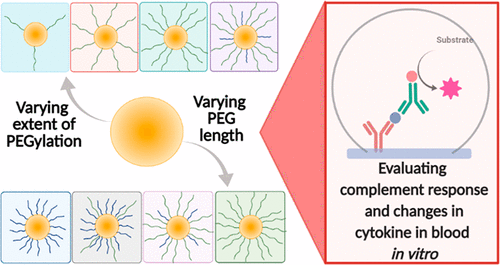当前位置:
X-MOL 学术
›
Bioconjugate Chem.
›
论文详情
Our official English website, www.x-mol.net, welcomes your
feedback! (Note: you will need to create a separate account there.)
Engineering PEGylated Polyester Nanoparticles to Reduce Complement-Mediated Infusion Reaction
Bioconjugate Chemistry ( IF 4.0 ) Pub Date : 2021-09-09 , DOI: 10.1021/acs.bioconjchem.1c00339 Nuzhat Maisha 1 , Nidhi Naik 1 , Mawuyon Okesola 1 , Tobias Coombs 1 , Rose Zilberberg 1 , Narendra Pandala 1 , Erin Lavik 1
Bioconjugate Chemistry ( IF 4.0 ) Pub Date : 2021-09-09 , DOI: 10.1021/acs.bioconjchem.1c00339 Nuzhat Maisha 1 , Nidhi Naik 1 , Mawuyon Okesola 1 , Tobias Coombs 1 , Rose Zilberberg 1 , Narendra Pandala 1 , Erin Lavik 1
Affiliation

|
Translation of intravenously administered nanomaterials to the clinic is limited due to adverse infusion reactions. While these reactions are infrequent, with up to 10% prone to experiencing infusion reactions, the reactions can be severe and life-threatening. One of the innate immune pathways, the complement activation pathway, plays a significant role in mediating this response. Nanoparticle surface properties are a relevant design feature, as they control the blood proteins the nanoparticles interact with and allow the nanoparticles to evade the immune reaction. PEGylation of nanosurfaces is critical in improving the blood circulation of nanoparticles and reducing opsonization. Our goal was to understand whether modifying the surface architecture by varying the PEG density and architecture can impact the complement response in vitro. We utilized block copolymers of poly(lactic acid)-b-poly(ethylene glycol) prepared with poly(ethylene glycol) macroinitiators of molecular weights 3400 and 5000 Da. Tracking the complement biomarker C5a, we monitored the impact of changing PEGylation of the nanoparticles. We also investigated how the changing PEG length on the nanoparticle surface impacts further strengthening the stealth properties. Lastly, we determined which cytokines change upon blood incubation with nanoparticles in vitro to understand the extent to which inflammation may occur and the crosstalk between the complement and immune responses. Increasing PEGylation reduced the generation of complement-mediated anaphylatoxin C5a in vitro, with 5000 Da PEG more effectively reducing levels of C5a generated compared to 3400 Da PEG. The insights gathered regarding the impact of PEG density and PEG chain length would be critical in developing stealth nanoparticles that do not lead to infusion reactions upon intravenous administration.
中文翻译:

工程化聚乙二醇化聚酯纳米颗粒以减少补体介导的输注反应
由于输注不良反应,静脉注射纳米材料向临床的转化受到限制。虽然这些反应并不常见,但高达 10% 的人可能会出现输液反应,但这些反应可能很严重并危及生命。先天免疫途径之一,补体激活途径,在介导这种反应中发挥着重要作用。纳米颗粒的表面特性是一个相关的设计特征,因为它们控制与纳米颗粒相互作用的血液蛋白,并允许纳米颗粒逃避免疫反应。纳米表面的聚乙二醇化对于改善纳米颗粒的血液循环和减少调理作用至关重要。我们的目标是了解通过改变 PEG 密度和结构来修饰表面结构是否会影响体外补体反应。我们使用由分子量为3400和5000Da的聚(乙二醇)大分子引发剂制备的聚(乳酸) -b-聚(乙二醇)嵌段共聚物。通过追踪补体生物标志物 C5a,我们监测了改变纳米颗粒聚乙二醇化的影响。我们还研究了改变纳米粒子表面的 PEG 长度如何影响进一步增强的隐形性能。最后,我们确定了血液与纳米粒子在体外孵育时哪些细胞因子发生变化,以了解炎症可能发生的程度以及补体和免疫反应之间的串扰。增加聚乙二醇化可减少体外补体介导的过敏毒素 C5a 的产生,与 3400 Da PEG 相比,5000 Da PEG 更有效地降低产生的 C5a 水平。 收集到的有关 PEG 密度和 PEG 链长度影响的见解对于开发静脉注射时不会导致输注反应的隐形纳米颗粒至关重要。
更新日期:2021-10-20
中文翻译:

工程化聚乙二醇化聚酯纳米颗粒以减少补体介导的输注反应
由于输注不良反应,静脉注射纳米材料向临床的转化受到限制。虽然这些反应并不常见,但高达 10% 的人可能会出现输液反应,但这些反应可能很严重并危及生命。先天免疫途径之一,补体激活途径,在介导这种反应中发挥着重要作用。纳米颗粒的表面特性是一个相关的设计特征,因为它们控制与纳米颗粒相互作用的血液蛋白,并允许纳米颗粒逃避免疫反应。纳米表面的聚乙二醇化对于改善纳米颗粒的血液循环和减少调理作用至关重要。我们的目标是了解通过改变 PEG 密度和结构来修饰表面结构是否会影响体外补体反应。我们使用由分子量为3400和5000Da的聚(乙二醇)大分子引发剂制备的聚(乳酸) -b-聚(乙二醇)嵌段共聚物。通过追踪补体生物标志物 C5a,我们监测了改变纳米颗粒聚乙二醇化的影响。我们还研究了改变纳米粒子表面的 PEG 长度如何影响进一步增强的隐形性能。最后,我们确定了血液与纳米粒子在体外孵育时哪些细胞因子发生变化,以了解炎症可能发生的程度以及补体和免疫反应之间的串扰。增加聚乙二醇化可减少体外补体介导的过敏毒素 C5a 的产生,与 3400 Da PEG 相比,5000 Da PEG 更有效地降低产生的 C5a 水平。 收集到的有关 PEG 密度和 PEG 链长度影响的见解对于开发静脉注射时不会导致输注反应的隐形纳米颗粒至关重要。











































 京公网安备 11010802027423号
京公网安备 11010802027423号